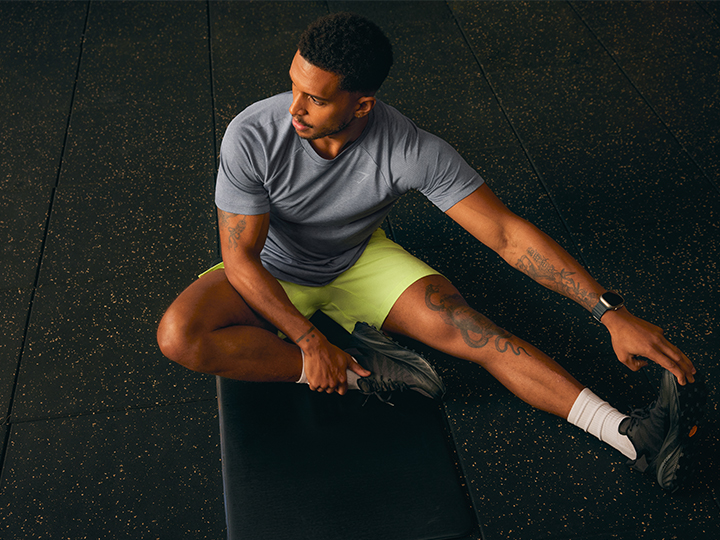When it comes to running and improving speed and stride length, it's easy to get hung up on minor details and overcomplicated approaches.
The two most significant factors that directly impact our pace are stride length and stride cadence/frequency.
Improving these two factors isn't easy, and stepping out of your comfort zone during training will be the best way to force physical and psychological adaptations.
Improving your running speed and efficiency requires a consistent training plan that focuses on the key areas of stride length and cadence.
In this article, we've put together six tips to help you achieve just that.
So what's the difference?
Stride length refers to the distance traveled with each step as you propel yourself forward from one foot to another when running. The greater the stride length, the faster you run, right?
Not quite.
We also have to account for stride cadence, which is how many steps you take per minute.
Improving on these two elements of your running will no doubt get you running faster, but we also need to sustain that pace from a cardiovascular point of view. There's no point keeping up with Kipchogi, at a stride length of 1.96m and a cadence of 180 steps per minute, if you can only manage it for 30 seconds...
6 Tips For Improving Running Speed And Efficiency
Strength Training
Sprints & Intervals
Aerobic Conditioning
Goal Setting
Running Analysis
Mobility & Flexibility
1. Strength Training
You're on the Gymshark website, so this first one was always going to be on the list...
But there's a good reason for it. Stronger, more powerful muscles can help us leap further with every stride, creating more efficient running dynamics while reducing the risk of injury.
Building a foundation of muscular strength and maximal strength training has been shown to increase running economy and increase time to exhaustion with no negative impact on maximum oxygen uptake.
Essentially, you'll be covering more ground with the same effort. That's a win-win, we think.
We're not just talking about heavy lifts either, plyometric exercises can help build speed and power which can be carried over to our daily miles and race days.
If you need guidance on lower body strength exercises, our ultimate guide to leg training is a great place to start!
2. Sprints & Intervals
Not every runner's cup of tea. But the best way to get faster is by running faster.
As simple as it sounds, incorporating sprints into your training can help build power and speed while generating sport-specific muscular responses.
Combining sprints with intervals can be a great way to boost cardiovascular endurance, too, so try a few sessions where you combine the two and other sessions that focus on one or the other.
This study found that reducing weekly running mileage in favor of intermittent sprints and plyometrics improved 10km running performance in subjects.
3. Aerobic Conditioning
Like we already said, running at Kipchogi's speed is achievable, but matching his pace for distance? That's impossible for most.
Working on our aerobic conditioning will allow us to maintain a faster pace for extended periods.
A study on the impact of high-intensity and continuous training methods for runners led to significant improvemessentialunners' aerobic fitness and general health.
4. Goal Setting
Goal setting is an important aspect of succeeding, and it's no different when it comes to running.
How fast do you actually want to run? What's your goal pace? How frequently can you train?
There are many questions to answer, but as you delve deeper into your personal running goals, you will begin to determine the steps to how you may achieve them.
Once your goals are set, it's time to create a training program you can stick to.
Steady miles, tempo runs, and intervals all have a place when it comes to improving our running speed and efficiency. Including variance in your training intensity can help keep things interesting when planning your weekly runs.
5. Running Analysis
If you're serious about running, then a running analysis could be the way to improve your efficiency and speed.
Getting expert advice on your running form and technique can work wonders, and there may be ways to tweak your running form to improve efficiency, reduce the chance of injury, and more!
Running analysis may also help identify your optimal blend of stride length and cadence for different distances, creating solid running markers to take you from 5ks to full-blow marathons.
6. Mobility & Flexibility
Often thought of as the same thing, mobility and flexibility refer to two different things. Improving both allows us to work through a full range of motion without impingements or limitations.
Flexibility refers to the muscles and their ability to lengthen through a range of motion, while mobility refers to the joint's ability to work through a full range of motion.
Working on both these aspects can help boost running performance while reducing the risk of injury.
Tight hip flexors could impact your stride length as you lift your knee above hip height. Reduced ankle mobility can lead to reduced plantar and dorsiflexion, negatively affecting running efficiency and increasing the risk of injury.
Improving your mobility and flexibility is a great way to keep you injury free and moving efficiently, allowing you to focus on your goals and training plan.
Whether you're new to running or regularly take to the pavement, treadmill or track, by implementing some or all of the tips above, you'll be well on your way to achieving faster running paces with greater efficiency.
. . .
WRITTEN BY: CHRIS BECK
Chris Beck is Senior Editor at Gymshark, with a passion for writing informative conditioning, health and fitness tech content. Chris is an avid gym-goer and ex-international athlete, holds qualifications in Personal Training, Nutrition, and Sports Performance, and is a certified Crossfit Level 1 Trainer.

